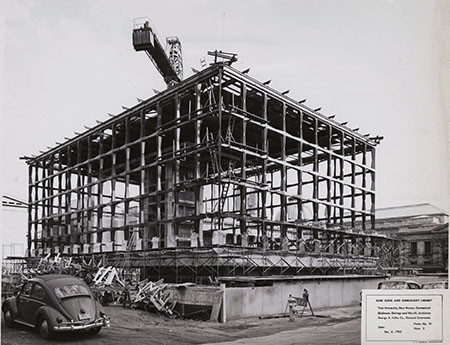One of the great delights of working inside the iconic Beinecke Rare Book & Manuscript Library, designed by Gordon Bunshaft and completed in 1963, is that no matter where one looks, there seems to be some deeper meaning nested in the building’s design and architecture. The semi-transparent marble “windows” are one of the most obvious charms, a symbol for the scholarly endeavor that is hard to miss. Standing on the plaza on a sunny day, a person can be dazzled by the play of light on marble, and then dazzled again, in a different way, upon entering the building and seeing the light absorbed and transformed by the marble panels, like a shape-shifting modernist painting or a flickering candle flame. It is not much of a stretch to compare the idea of the absorption and reflection of light to scholars who enter the Beinecke to consult its collections and go on to teach or publish their research.
On the ground level, Yale’s 1742 Library (so-called for the year that it was catalogued) forms the cornerstone of the glass stack tower. The deliberate placement of Yale’s earliest library in the southwest corner of the tower echoes the way the collection of books, many of them antiquarian in the eighteenth century, formed the cornerstone of Yale College when it received its charter in 1701.
The Beinecke was built to be a state-of-the-art repository for Yale’s rare book and manuscript collections. Yale’s 42-line paper copy of the Gutenberg Bible, in two volumes, was placed on permanent exhibition on the mezzanine, a physical testament to the tension that existed between manuscript culture and mechanized print in the fifteenth century. A similar tension resonates sharply today, as digital media looks to establish itself in a material way within in the archival record.
On Tuesday, May 19, 2015, the Beinecke will close to the public and embark on a sixteen-month renovation. While the curators, librarians, archivists, cataloguers and staff will carry on their work with collections and readers, the landmark building at 121 Wall Street will get some much-needed rest and rehabilitation.
Much about the physical space of the Beinecke will be missed during the next sixteen months. However, collections will still be accessible through the temporary reading room and classroom at Sterling Memorial Library, as well as through our digital library and other discovery tools. And fear not: the aesthetics of the building will remain unchanged, as much of the rehabilitation is mechanical.
To see more than 500 photographs documenting the construction of Beinecke Library from 1961 to 1963, please visit our digital library.
